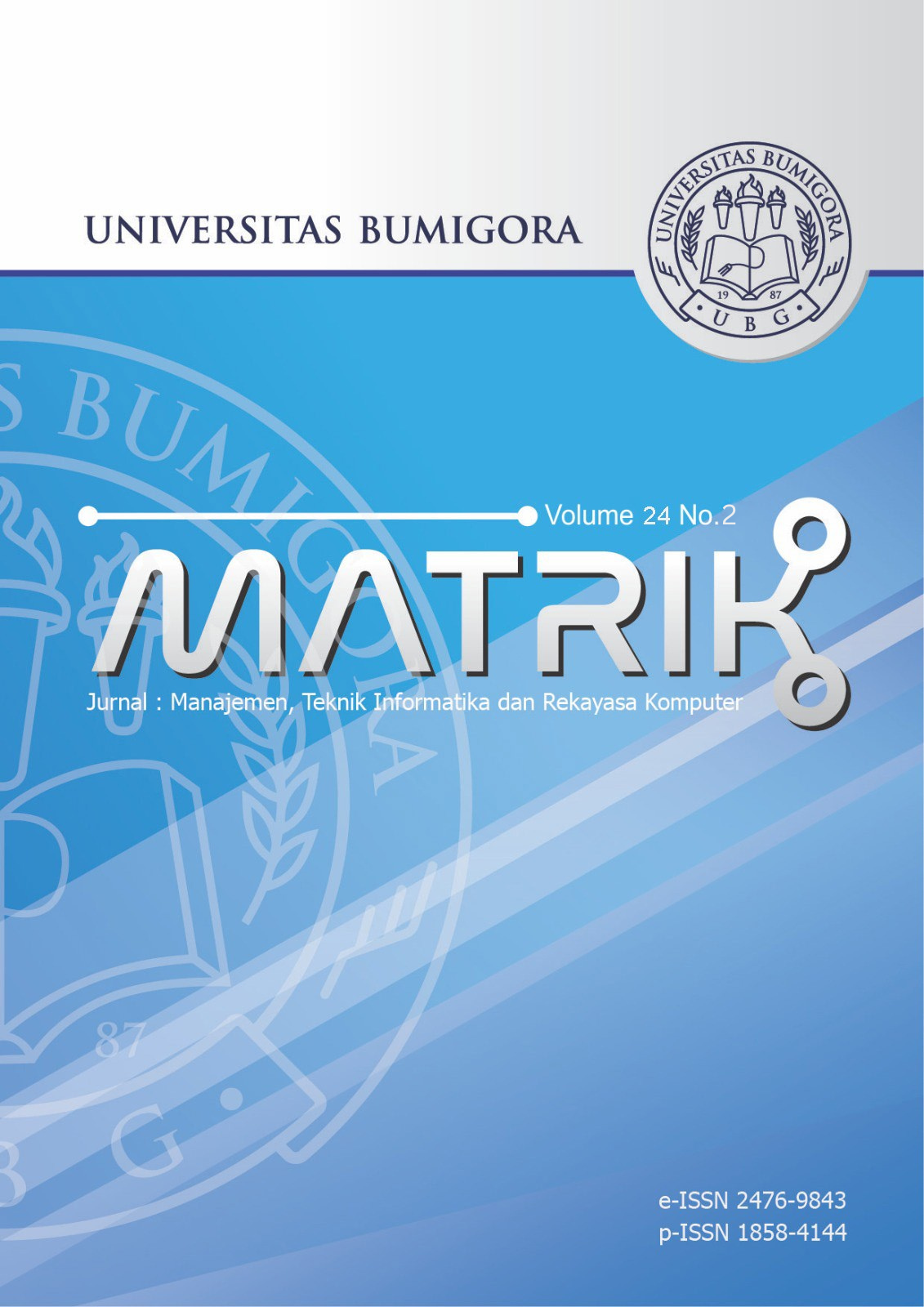Sentiment Study of ChatGPT on Twitter Data with Hybrid K-Means and LSTM
Analisis Sentimen Berdasarkan Hasil Klasterisasi K-Means pada Data Pengguna ChatGPT Menggunakan LSTM
DOI:
https://doi.org/10.30812/matrik.v24i2.4791Keywords:
Chat-Gpt, K-Means, Long Short-Term Memory, Sentiment Analysis, TF-IDF, Word2VecAbstract
The rapid evolution of artificial intelligence (AI) has transformed the way people interact with technology, with ChatGPT emerging as a standout innovation in natural language processing (NLP). While it offers immense benefits, such as improving productivity and accessibility, it has also sparked debates about trust, transparency, and user experience. This makes understanding public sentiment about ChatGPT both timely and essential.This study explores user sentiments by combining K-Means clustering and Long Short-Term Memory (LSTM) models for analysis. The research utilized a dataset from Kaggle, which underwent extensive preprocessing, including text cleaning, tokenization, and lemmatization. Key features were extracted using TF-IDF and Word2Vec techniques, while clustering was refined with the Elbow Method and Silhouette Score. The data was grouped into three clusters focusing on ChatGPT’s functions, its developers, and user activities. Sentiment analysis using LSTM achieved an impressive accuracy of 98% after five training cycles. The findings highlight that negative sentiments, particularly around technical challenges and transparency, dominate user feedback, signaling areas for improvement. While positive sentiments exist, they remain overshadowed by critical perspectives. This study underscores the importance of enhancing user trust and experience while ensuring ethical and transparent AI development. The insights provided aim to guide developers and policymakers in creating AI technologies that are more user-focused and socially responsible. Future research should include multilingual and cross-platform data to paint a more comprehensive picture.
Downloads
References
[2] F. M. Sinaga, S. J. Pipin, S. Winardi, K. M. Tarigan, and A. P. Brahmana, “Analyzing Sentiment with Self-Organizing Map and Long Short-Term Memory Algorithms,†Matrik: Jurnal Manajemen, Teknik Informatika dan Rekayasa Komputer, vol. 23, no. 1, 2024. DOI: 10.30812/matrik.v23i1.3332.
[3] Y. Akbar and T. Sugiharto, “Analisis Sentimen Pengguna Twitter di Indonesia Terhadap ChatGPT Menggunakan Algoritma C4.5 dan Naïve Bayes,†Jurnal Sains dan Teknologi, vol. 5, no. 1, pp. 115–122, 2023. DOI: 10.55338/saintek.v4i3.1368.
[4] D. Setiawan, D. Arsa, L. E. Fitri, and F. F. P. Zahardy, “Comparative Analysis of Clustering Approaches in Assessing ChatGPT User Behavior,†Cogito: Jurnal Penelitian dan Pengabdian Masyarakat, vol. 10, no. 2, pp. 366–379, 2024. DOI: 10.31154/cogito.v10i2.661.366-379.
[5] P. Yani and H. Baturohmah, “Analisis Sentimen Terhadap ChatGPT Plus Menggunakan Naïve Bayes di Twitter,†Sismatik: Jurnal Sistem Informasi dan Teknik Informatika, 2024. [Online]. Available: https://sismatik.nusaputra.ac.id/index.php/sismatik/article/view/210.
[6] I. Kurniasari, A. A. Alfin, and E. Widodo, “Implementasi Long Short-Term Memory (LSTM) dan Word Embedding Model pada Analisis Sentimen Layanan Uang Elektronik Ovo dan Link Aja,†Informasi: Jurnal Informatika dan Sistem Informasi, vol. 15, no. 2, 2023. DOI: 10.37424/informasi.v15i2.273.
[7] I. Dergaa, K. Chamari, P. Zmijewski, and H. B. Saad, “From human writing to artificial intelligence generated text: examining the prospects and potential threats of ChatGPT in academic writing,†Biology of Sport, 2023. DOI: 10.5114/biolsport.2023.125623.
[8] A. Nurkholis, D. Alita, and A. Munandar, “Comparison of Kernel Support Vector Machine Multi-Class in PPKM Sentiment Analysis on Twitter,†Jurnal RESTI (Rekayasa Sistem dan Teknologi Informasi), vol. 6, no. 2, pp. 227–233, 2022. DOI: 10.29207/resti.v6i2.3906.
[9] K. Maharana, S. Mondal, and B. Nemade, “A review: Data pre-processing and data augmentation techniques,†Global Transitions Proceedings, 2022. DOI: 10.1016/j.gltp.2022.04.020.
[10] R. R. Salam, M. F. Jamil, Y. Ibrahim, R. Rahmaddeni, S. Soni, and H. Herianto, “Sentiment Analysis of Cash Direct Assistance Distribution for Fuel Oil Using Support Vector Machine,†Jurnal Malcom, vol. 3, no. 1, 2023. DOI: 10.57152/malcom.v3i1.590.
[11] R. Sulthana, J. A. K., H. Harikrishnan, and V. Varadarajan, “Sentiment Analysis on Movie Reviews Dataset Using Support Vector Machines and Ensemble Learning,†International Journal of Information Technology and Web Engineering, vol. 17, no. 1, 2023. DOI: 10.4018/IJITWE.311428.
[12] F. Muftie, K. M. Yafi, and Q. M. Addina, “Perbandingan Performa Deteksi Cyberbullying dengan Transformer, Deep Learning, dan Machine Learning,†Jurnal Pendidikan Informatika dan Sains, vol. 13, no. 1, pp. 75–87, 2024. DOI: 10.31571/saintek.v13i1.4002.
[13] A. Sanmorino, Suryati, R. Gustrianysah, S. Puspasari, and N. Ariati, “Feature Extraction vs Fine-tuning for Cyber Intrusion
Detection Model,†Jurnal INFOTEL, vol. 16, no. 2, pp. 302–315, 2024. DOI: 10.20895/infotel.v16i2.996.
[14] A. Nurdin, B. A. S. Aji, A. Bustamin, and Z. Abidin, “Perbandingan Kinerja Word Embedding Word2Vec, GloVe, dan FastText pada Klasifikasi Teks,†Jurnal TEKNOKOMPAK, vol. 14, no. 2, pp. 74–79, 2020. DOI: 10.33365/jtk.v14i2.732.
[15] E. T. Wijaya, “Perancangan Information Retrieval (IR) Berbasis Term Frequency-Inverse Document Frequency (TF-IDF) untuk Peringkasan Teks Tugas Khusus Berbahasa Indonesia,†Jurnal Ilmiah Teknologi dan Informasi ASIA, vol. 7, no. 1, 2013. [Online]. Available: https://jurnal.stmikasia.ac.id/index.php/jitika/article/view/78.
[16] M. Guntara and N. Lutfi, “Cacah Klaster pada Klasterisasi dengan Algoritma K-Means Menggunakan Silhouette Coeficient
dan Elbow Method,†JuTI: Jurnal Teknologi Informasi, vol. 2, no. 1, Aug. 2023. DOI: 10.26798/juti.v2i1.944.
[17] A. T. Rahman, Wiranto, and R. Anggrainingsih, “Coal Trade Data Clusterung Using K-Means (Case Study PT. Global Bangkit Utama),†ITSMART: Jurnal Ilmiah Teknologi dan Informasi, vol. 6, no. 1, Jun. 2017. DOI: 10.20961/itsmart.v6i1.11296.
[18] M. Anggara, H. Sujiani, and H. Nasution, “Pemilihan Distance Measure Pada K-Means Clustering Untuk Pengelompokkan Member Di Alvaro Fitness,†Jurnal Teknik Informatika Universitas Tanjungpura (JUSTIN), 2023. [Online]. Available: https://jurnal.untan.ac.id/index.php/justin/article/view/13119.
[19] M. Robani and A. Widodo, “Algoritma K-Means Clustering Untuk Pengelompokan Ayat Al Quran Pada Terjemahan Bahasa Indonesia,†Jurnal Sistem Informasi Bisnis, vol. 6, no. 2, pp. 164–176, Dec. 2016. DOI: 10.21456/vol6iss2pp164- 176.
Downloads
Published
Issue
Section
How to Cite
Similar Articles
- Mochamad Wahyudi, Firmansyah Firmansyah, Analisis Performa Open Shortest Path First Load Balancing dengan Metode Cost Manipulation , MATRIK : Jurnal Manajemen, Teknik Informatika dan Rekayasa Komputer: Vol. 21 No. 3 (2022)
- Angelina Ervina Jeanette Egeten, Yanes Hardianto S, Putri Ayu P, Okky Marita S, Analisis dan Perancangan Sistem Informasi E-Procurement Modul pada Pemesanan Barang Non Produksi di PT Toyota Motor Manufacturing Indonesia , MATRIK : Jurnal Manajemen, Teknik Informatika dan Rekayasa Komputer: Vol. 17 No. 2 (2018)
- Lilik Widyawati, Imam Riadi, Yudi Prayudi, Comparative Analysis of Image Steganography using SLT, DCT and SLT-DCT Algorithm , MATRIK : Jurnal Manajemen, Teknik Informatika dan Rekayasa Komputer: Vol. 20 No. 1 (2020)
- Bob Subhan Riza, Jufriadif Na'am, Sumijan Sumijan, Tuberculosis Extra Pulmonary Bacilli Detection System Based on Ziehl Neelsen Images with Segmentation , MATRIK : Jurnal Manajemen, Teknik Informatika dan Rekayasa Komputer: Vol. 22 No. 1 (2022)
- Dedi Setiadi, Yogi Isro Mukti, Electronic Tourism Using Decision Support Systems to Optimize the Trips , MATRIK : Jurnal Manajemen, Teknik Informatika dan Rekayasa Komputer: Vol. 23 No. 1 (2023)
- Eka Hartati, Mardiana Mardiana, Evaluasi Penerapan Computer Based Test (CBT) sebagai Upaya Perbaikan Sistem pada Ujian Nasional untuk Sekolah Terpencil di Sumatera Selatan , MATRIK : Jurnal Manajemen, Teknik Informatika dan Rekayasa Komputer: Vol. 18 No. 1 (2018)
- I Putu Hariyadi, Khairan Marzuki, Implementation of Configuration Management Virtual Private Server Using Ansible , MATRIK : Jurnal Manajemen, Teknik Informatika dan Rekayasa Komputer: Vol. 19 No. 2 (2020)
- M. Khairul anam, Esi Tri Emerlada, Susi Erlinda, Tashid Tashid, Torkis Nasution, The Application of Usability Testing to Analyze the Quality of Android-Based Acupressure Smart Chair Applications , MATRIK : Jurnal Manajemen, Teknik Informatika dan Rekayasa Komputer: Vol. 22 No. 2 (2023)
- Christofer Satria, Anthony Anggrawan, Tinjauan Kritis Jurnal Ilmiah: “The Influence of Transformational Leadership and Organizational Culture on Learning Organization: a Comparative Analysis of The it Sector†, MATRIK : Jurnal Manajemen, Teknik Informatika dan Rekayasa Komputer: Vol. 18 No. 1 (2018)
- Bobby Poerwanto, Fajriani Fajriani, Resilient Backpropagation Neural Network on Prediction of Poverty Levels in South Sulawesi , MATRIK : Jurnal Manajemen, Teknik Informatika dan Rekayasa Komputer: Vol. 20 No. 1 (2020)
You may also start an advanced similarity search for this article.


.png)












